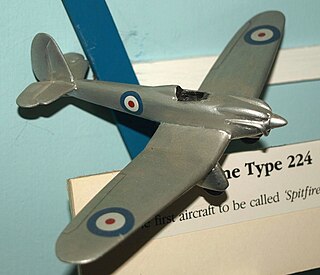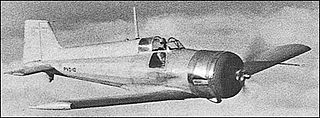Design and development
The F.5/34 was the first monoplane fighter built by Gloster and the last design by H.P. Folland for the company. It was also Gloster's first land monoplane.
The first design was based on a low-wing monoplane version of the Gladiator, probably retaining the fabric covering and with the fin and full-height rudder behind the tailplane, as for the Gladiator. The engine was to be the new Bristol Perseus sleeve-valve radial. The cockpit was semi-enclosed, with open sides and a spine behind it. The undercarriage retracted backwards and left the wheels half-exposed, which would reduce damage in the event of a wheels-up landing.
By 1935, the design had changed and had acquired a number of more modern features such as a metal stressed-skin fuselage throughout. The cockpit canopy was now a glazed and framed canopy like that of the production Gladiator which slid backwards to open, giving much better vision above and behind. Although the main dimensions remained unchanged, the tailplane moved backwards behind the fin, requiring an extension of the fuselage beyond it, increasing the length by 3 feet. This was an innovation developed for the F.35/35 high-speed fighter specification. The intention was to improve spin recovery, by having the fin and rudder in 'clean' air, ahead of the tailplane.
The engine also changed, at least for the prototype aircraft, to the older 840 hp Bristol Mercury IX nine-cylinder poppet-valve radial engine. The Perseus had been developed with identical cylinder dimensions to the Mercury and was only a little larger, making the change an easy one. The Perseus was still under development and although it was expected - accurately - that the sleeve valve powerplant proffered much greater potential horsepower, the more conventional Mercury was deemed acceptable for the purposes of developing the prototype airframe, with a view to restoring the Perseus in the production version.
The new aircraft, now informally referred to as the Unnamed Fighter, featured many of the trademark Gloster design elements including the tail and close-fitting cowling that resembled the earlier Gauntlet and Gladiator biplane fighters. The low wing cantilever mainplane was built in one piece with light-alloy spars running through from tip to tip and ribs made from channelling with steel and light-alloy tube struts. NACA 2218 profiles were used at the root and NACA 2209 at the tip. The single piece wing was later criticised as it would have prevented battle damage being repaired by replacing a single wing. Duralumin stressed-skin was used on the mainplane and tail unit with fabric-covered Frise ailerons. The fuselage was a monocoque structure built up from light, fabricated oval-section rings with duralumin skinning.
Whereas the usual British practice was to order a single prototype for purposes of evaluation, as with the Spitfire and Hurricane, in the case of the F.5/34 two machines were requested. Development was delayed by the demands of the Gladiator production programme, so that flight trials of the first prototype K5604 did not commence until December 1936. The second prototype K8089 did not fly until March 1938.

The Bristol Mercury is a nine-cylinder, air-cooled, single-row, piston radial engine. Designed by Roy Fedden of the Bristol Aeroplane Company it was used to power both civil and military aircraft of the 1930s and 1940s. Developed from the earlier Jupiter engine, later variants could produce 800 horsepower (600 kW) from its capacity of 1,500 cubic inches by use of a geared supercharger.

The Gloster Gladiator is a British-built biplane fighter. It was used by the Royal Air Force (RAF) and the Fleet Air Arm (FAA) and was exported to a number of other air forces during the late 1930s.

The Gloster E.28/39, was the first British jet-engined aircraft and first flew in 1941. It was the fourth jet to fly, after the German Heinkel He 178 (1939), the Italian Caproni Campini N.1 motorjet (1940), and the German Heinkel He 280 (1941).

The Blackburn B-24 Skua was a carrier-based low-wing, two-seater, single-radial engine aircraft operated by the British Fleet Air Arm which combined the functions of a dive bomber and fighter. It was designed in the mid-1930s and saw service in the early part of the Second World War. It took its name from the sea bird.

The Hawker Fury is a British biplane fighter aircraft used by the Royal Air Force in the 1930s. It was a fast, agile aircraft, and the first interceptor in RAF service capable of speed higher than 200 mph. It was the fighter counterpart to the Hawker Hart light bomber.

The Hawker Henley was a British two-seat target tug derived from the Hawker Hurricane that was operated by the Royal Air Force during the Second World War.

The Gloster Gauntlet was a single-seat biplane fighter designed and produced by the British aeroplane manufacturer Gloster Aircraft in the 1930s. It was the last fighter to be operated by the Royal Air Force (RAF) to have an open cockpit, and also the penultimate biplane fighter in its service.

The Gregor FDB-1 was a Canadian biplane fighter, designed in 1938 by Michael Gregor and manufactured by Canadian Car and Foundry. Despite having some advanced design features such as flush rivetted all-metal construction and a retractable undercarriage, the final generation of biplane fighters was being supplanted by monoplanes and the Gregor FDB-1 was obsolete before it flew. Despite the Royal Canadian Air Force's desperation for modern fighters, the sole example remained unsold and was eventually lost in a fire in 1945. The Gregor FDB-1's model designation stood for Fighter Dive Bomber indicating its intended roles.

The Gloster E.1/44 was a British single-engined jet fighter design of the Second World War, developed and produced by the British aviation firm Gloster Aircraft Company. It was amongst the first jet-propelled aircraft to be developed and was produced on an experimental basis.
The Fairey P.4/34 was a competitor for an order for a light bomber to serve with the Royal Air Force. Although not produced in that form, it formed the basis for the Fulmar long-range carrier-based fighter for the Fleet Air Arm.
The Hawker P.V.3 was a British single-engined biplane fighter prototype of the 1930s. Only a single example was built, the Gloster Gladiator being selected instead to fulfill the requirement to which it was designed.

The Supermarine Type 224 was an inverted gull-wing monoplane fighter aircraft designed by R.J. Mitchell at Supermarine in response to Air Ministry Specification F.7/30, which sought a fighter for introduction to succeed the Gloster Gauntlet. It was powered by the Rolls-Royce Goshawk engine, which used an experimental evaporative cooling system, and problems with this system, combined with its disappointing performance, led to it being rejected, a contract for production aircraft eventually going to the Gloster Gladiator. It is nevertheless notable because R.J. Mitchell learnt lessons from its failure that were to contribute greatly to his success with the Supermarine Spitfire.

The Gloster Goring was a single-engined two-seat biplane designed to meet 1926 Air Ministry specifications for a day/torpedo bomber. It was not put into production and the one aircraft built served later as an engine testbed.

The Bristol Type 133 was a single-seat, single-engine monoplane fighter armed with four guns, using stressed-skin construction and with a retractable undercarriage. It was built by The Bristol Aeroplane Co. to meet Specification F.7/30. The single example crashed before the trials commenced.

The Bristol Type 146 was a British single-seat, eight-gun fighter monoplane prototype built to a mid-1930s Air Ministry contract. Powered by a radial engine, it was outclassed by Merlin-engined fighters and only one was built.

The Bristol Type 148 was a two-seat, single-engine low-wing monoplane built in 1937 to an Air Ministry specification for an army cooperation aircraft. It lost in the competition to the Westland Lysander and did not progress past the two prototypes that were built.

The Vickers Type 279 Venom was a British low-wing monoplane single-seat, single-engined, eight-gun fighter aircraft. It was fast and manoeuvrable but its Bristol Aquila radial engine was underpowered. Together with other designs built to the same specification, which included the Bristol Type 146, Gloster F.5/34, and Martin-Baker MB 2, it was rejected by the Air Ministry and only one Venom was built.

The Vickers Type 151 Jockey was an experimental low-wing monoplane interceptor fighter powered by a radial engine. It was later modified into the Type 171 Jockey II, which had a more powerful engine and detail improvements. Only one was built; it was lost before its development was complete, but the knowledge gained enabled Vickers to produce the more refined Venom.

The Westland F.7/30 was a British fighter prototype. A single prototype was built in 1934, but the type was not put in production because its performance fell far below the RAF's requirements. The Gloster Gladiator won the F.7/30 competition.

The Tupolev I-14 was a Soviet fighter aircraft of the 1930s. It was a single-engined, single-seat monoplane with retractable undercarriage, designed to carry heavy armament, and as such was one of the most advanced fighters of its time. It was ordered into production, but this was cancelled after only a small number had been built, the competing Polikarpov I-16 being preferred.



















